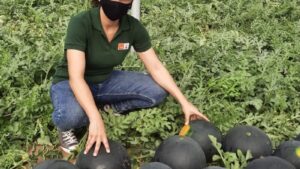Certified organic growers are looking to source more organic seed at the request of certifiers.
Why is organic seed important to the integrity of agriculture? Seed is the important first link in any production system and provides farmers the genetic tools to confront the day-to-day challenges in the field, says Kristina Hubbard, Organic Seed Alliance director of advocacy and communications.
Hubbard says the challenges of organic farmers can be quite different from their conventional counterparts, including the solutions available to solve those challenges.
“Organic seed is really important to the integrity of the organic label,” Hubbard says. “By ‘integrity,’ we don’t just talk about what’s not wanted in organic systems, such as pesticide residue or genetically-engineered traits. But by ‘integrity,’ we also mean what’s desired in the seed being bred, sown and produced — from production traits to nutritional quality to also supporting production systems that use resources more sustainably.”
Seed varieties bred and produced in organic conditions provide growers with genetics that are better adapted to the low-input systems and practices, Hubbard says, noting that the literature is growing on this point. “We are encouraged by all of the improvements in this area, including some investments in organic plant breeding that’s delivering better genetics for organic growers,” she adds.
Breeding Organic Cultivars
One example of this is a group of plant breeders from New Mexico, Illinois, Iowa and New York working together through a grant from the U.S. Department of Agriculture’s National Institute of Food and Agriculture as part of the Organic Research Extension Initiative.
Together, they are working to strengthen public corn breeding to ensure that organic farmers have access to elite cultivars. The first grant was awarded in 2010 and the group just received funding for another four years.
“We’ve created a pipeline with a few inbred lines that have been produced and released,” says Paul Scott, of USDA’s Agricultural Research Service Corn Insects and Crop Genetics Research Unit. Scott has been on the ground in Lajas, Puerto Rico, working in an organically-certified winter nursery to breed organic corn in an organic production system. “Today, the pipeline is full, and if it continues to go well, we will continue to release more varieties.”
One of the organic hybrids that’s bred for organic production systems — a result of USDA funding — is D2901, which is available through Blue River Hybrids, Albert Lee Seed House and Lake View Organic. That hybrid went on the market about two years ago, Scott notes.
Hubbard says that when seed is bred with organic production systems in mind and the diverse organic markets that farmers serve, “food processors and retailers benefit from these improved traits that organic consumers value — including nutrition, flavor, color and other quality traits that are increasingly being emphasized by our organic plant breeding community.”
Organic seed production can provide economic opportunities to growers who successfully integrate organic seed into their production systems. Hubbard says the economic benefits range from becoming more seed self-sufficient to reducing input costs and risks by having seed better adapted for their farm, as well as engaging in commercial seed production.
“Despite the importance of organic seed and the organic industry’s impressive growth each year, where the organic food industry now represents more than $30 billion, the organic seed sector has simply not caught up to meet the demand of the increased acreage and growing market,” Hubbard says.
In 2009, the Organic Seed Alliance launched the “State of Organic Seed” project, which is an ongoing project that monitors the status of organic seed systems in the United States. Part of this project is to establish an ongoing assessment of the challenges in building an organic seed sector, monitoring the organic seed community’s progress and engaging the organic community.
Through the State of the Organic Seed report, first published in 2011, Hubbard found that only 20 percent of the farmers surveyed used organic seed 100 percent of the time. The remaining 80 percent indicated that variety availability was the biggest factor, especially in vegetables.
“We also found that, although price is not an allowable factor for not sourcing organic seed, more than 40 percent of respondents still indicated that price was a moderate to significant factor when choosing not to source organic seed,” Hubbard reports. The survey was national in scope and included certified organic crop growers in 45 states.
The good news is despite challenges of sourcing organic seed, organic seed use is improving, Hubbard says. More than half of the respondents, 57 percent, indicated that during the past three years, they have increased the percentage of organic seed used on their farm. During the past three years, Hubbard says more certifiers have been requesting that growers take more steps to source organic seed — whether that’s doing more research, going beyond three sources, conducting variety trials on their farm. Sixty percent of respondents indicated that certifiers are asking them to take greater steps to source organic seed.
When encouraged to take additional steps to find organic seed, farmers responded by using more organic seed. Hubbard says this points to the need for certifiers to continue to request additional research, to go beyond three sources, to request trialing and other additional steps to encourage the use of organic seed.
“Organic farmers want organically bred varieties and we found that this was true across crop types,” Hubbard adds, noting that 83 percent of survey respondents indicated that varieties bred for organic system management are important to the overall success of organic agriculture. “We also found that certified organic growers want to be part of the solution. More than 50 percent are interested in producing organic seed commercially and conducting on-farm crop improvement projects if the economic opportunity and training are available.”
The 2011 State of Organic Seed report is available at seedalliance.org/uploads/publications/SOS_2011_Report.pdf.
Results from 2014 should be available soon.













